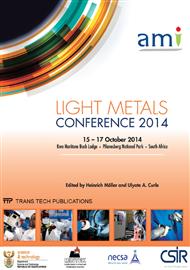[1]
B. Jager, Developments in Fischer-Tropsch Technology, Stud. Surf. Sci. Catal., vol. 119, (1998).
Google Scholar
[2]
A. Y. Khodakov, W. Chu, and P. Fongarland, Advances in the development of novel cobalt Fischer-Tropsch catalysts for synthesis of long-chain hydrocarbons and clean fuels., Chem. Rev., vol. 107, no. 5, p.1692–744, May (2007).
DOI: 10.1021/cr050972v
Google Scholar
[3]
R. L. Espinoza, a. P. Steynberg, B. Jager, and a. C. Vosloo, Low temperature Fischer–Tropsch synthesis from a Sasol perspective, Appl. Catal. A Gen., vol. 186, no. 1–2, p.13–26, Oct. (1999).
DOI: 10.1016/s0926-860x(99)00161-1
Google Scholar
[4]
S. Bessell, Support effects in cobalt-based fischer-tropsch catalysis, Appl. Catal. A Gen., vol. 96, no. 2, p.253–268, Mar. (1993).
DOI: 10.1016/0926-860x(90)80014-6
Google Scholar
[5]
J. Girardon, a Lermontov, L. Gengembre, P. Chernavskii, a Gribovalconstant, and a Khodakov, Effect of cobalt precursor and pretreatment conditions on the structure and catalytic performance of cobalt silica-supported Fischer?Tropsch catalysts, J. Catal., vol. 230, no. 2, p.339–352, Mar. (2005).
DOI: 10.1016/j.jcat.2004.12.014
Google Scholar
[6]
M. Kraum and M. Baerns, Fischer–Tropsch synthesis: the influence of various cobalt compounds applied in the preparation of supported cobalt catalysts on their performance, Appl. Catal. A Gen., vol. 186, no. 1–2, p.189–200, Oct. (1999).
DOI: 10.1016/s0926-860x(99)00172-6
Google Scholar
[7]
D. Schanke, S. Vada, E. A. Blekkan, A. M. Hilmen, A. Hoff, and A. Holmen, Study of Pt-Promoted Cobalt CO Hydrogenation Catalysts, J. Catal., vol. 156, p.85–95, (1995).
DOI: 10.1006/jcat.1995.1234
Google Scholar
[8]
J. Girardon, E. Quinet, a Gribovalconstant, P. Chernavskii, L. Gengembre, and a Khodakov, Cobalt dispersion, reducibility, and surface sites in promoted silica-supported Fischer–Tropsch catalysts, J. Catal., vol. 248, no. 2, p.143–157, Jun. (2007).
DOI: 10.1016/j.jcat.2007.03.002
Google Scholar
[9]
G. Jacobs, T. K. Das, Y. Zhang, J. Li, G. Racoillet, and B. H. Davis, Fischer–Tropsch synthesis: support, loading, and promoter effects on the reducibility of cobalt catalysts, Appl. Catal. A Gen., vol. 233, no. 1–2, p.263–281, Jul. (2002).
DOI: 10.1016/s0926-860x(02)00195-3
Google Scholar
[10]
N. Tsubaki, S. Sun, and K. Fujimoto, Different Functions of the Noble Metals Added to Cobalt Catalysts for Fischer–Tropsch Synthesis, J. Catal., vol. 199, no. 2, p.236–246, Apr. (2001).
DOI: 10.1006/jcat.2001.3163
Google Scholar
[11]
F. Diehl and A. Y. Khodakov, Promotion of cobalt Fischer-Tropsch catalysts with noble metals: A review, Oil Gas Sci. Technol., vol. 64, no. 1, p.11–24, (2009).
DOI: 10.2516/ogst:2008040
Google Scholar
[12]
G. Jacobs, J. a Chaney, P. M. Patterson, T. K. Das, J. C. Maillot, and B. H. Davis, Fischer-Tropsch synthesis: study of the promotion of Pt on the reduction property of Co/Al2O3 catalysts by in situ EXAFS of Co K and Pt LIII edges and XPS., J. Synchrotron Radiat., vol. 11, no. Pt 5, p.414–22, Sep. (2004).
DOI: 10.1107/s090904950401578x
Google Scholar
[13]
L. Guczi, D. Bazin, I. Kovacs, L. Borko, Z. Schay, J. Lynch, P. Parent, C. Lafon, G. Stefler, Z. Koppany, and I. Sajo, Structure of Pt-Co/Al2O3 and Pt-Co/NaY Bimetallic Catalysts: Characterization by In Situ EXAFS, TPR, XPS and by Activity in CO (Carbon Monoxide) Hydrogenation, Top. Catal., vol. 20, no. 1–4, p.129–139, (2002).
DOI: 10.1023/a:1016363702307
Google Scholar
[14]
C. J. Weststrate, a. M. Saib, and J. W. Niemantsverdriet, Promoter segregation in Pt and Ru promoted cobalt model catalysts during oxidation–reduction treatments, Catal. Today, vol. 215, p.2–7, Oct. (2013).
DOI: 10.1016/j.cattod.2013.01.009
Google Scholar
[15]
L. Jiao and J. R. Regalbuto, The synthesis of highly dispersed noble and base metals on silica via strong electrostatic adsorption: II. Mesoporous silica SBA-15, J. Catal., vol. 260, no. 2, p.342–350, Dec. (2008).
DOI: 10.1016/j.jcat.2008.09.023
Google Scholar
[16]
J. P. Brunelle, Preparation of catalysts by metallic complex adsorption on mineral oxides, Pure Appl. Chem., vol. 50, no. 9–10, p.1211–1229, (1978).
DOI: 10.1351/pac197850091211
Google Scholar
[17]
R. O. James and T. W. Healy, Adsorption of Hydrolyzable Metal Ions at the Oxide-Water Interface, J. Colloid Interface Sci., vol. 40, no. 1, (1972).
DOI: 10.1016/0021-9797(72)90174-9
Google Scholar
[18]
X. Hao, L. Quach, J. Korah, W. . Spieker, and J. R. Regalbuto, The control of platinum impregnation by PZC alteration of oxides and carbon, J. Mol. Catal. A Chem., vol. 219, no. 1, p.97–107, Sep. (2004).
DOI: 10.1016/j.molcata.2004.04.026
Google Scholar
[19]
S. Ardizzone, G. Spinolo, and S. Trasatti, The Point of Zero Charge of Co3O4 Prepared by Thermal Decomposition of Basic Cobalt Carbonate, Electrochem. Acta, vol. 40, no. 16, p.2683–2686, (1995).
DOI: 10.1016/0013-4686(95)00238-a
Google Scholar
[20]
P. H. Tewari and A. B. Campbell, Temperature dependence of point of zero charge of cobalt and nickel oxides and hydroxides, J. Colloid Interface Sci., vol. 55, no. 3, p.531–539, Jun. (1976).
DOI: 10.1016/0021-9797(76)90063-1
Google Scholar
[21]
M. L. Hair and W. Hertl, Acidity of surface hydroxyl groups, J. Phys. Chem., vol. 74, no. 1, p.91–94, Jan. (1970).
DOI: 10.1021/j100696a016
Google Scholar
[22]
E. van Steen, G. S. Sewell, R. A. Makhothe, C. Micklethwaite, H. Manstein, M. de Lange, and C. T. O'Connor, TPR Study on the Preparation of Impregnated Co/SiO2 Catalysts, J. Catal., no. 162, p.220–229, (1996).
DOI: 10.1006/jcat.1996.0279
Google Scholar
[23]
S. Sun, N. Tsubaki, and K. Fujimoto, The reaction performances and characterization of Fischer – Tropsch synthesis Co / SiO 2 catalysts prepared from mixed cobalt salts, vol. 202, p.121–131, (2000).
DOI: 10.1016/s0926-860x(00)00455-5
Google Scholar
[24]
H. E. Kissinger, Variation of peak temperature with heating rate in differential thermal analysis, J. Res. Natl. Bur. Stand. (1934)., vol. 57, no. 4, p.217, Oct. (1956).
DOI: 10.6028/jres.057.026
Google Scholar


